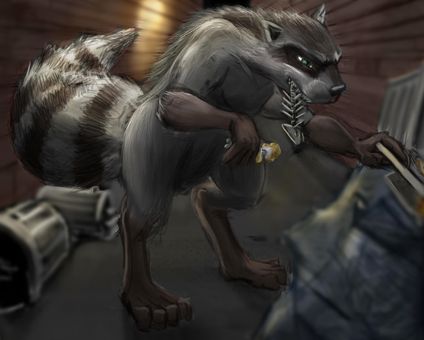

The Lonesome Road

| Climate/Terrain: | Temperate to subtropical woodlands and swamps |
|---|---|
| Frequency: | Rare |
| Organization: | Family |
| Activity Cycle: | Night |
| Diet: | Omnivore |
| Intelligence: | Average (8-10) |
| Treasure: | Nil |
| Alignment: | Chaotic evil |
| No. Appearing: | 2-6 |
| Armor Class: | 7 |
| Movement: | 12, 6 |
| Hit Dice: | 4+2 |
| THAC0: | 17 |
| No. of Attacks: | 1 |
| Damage/Attack: | By Weapon or 1d4+2 |
| Special Attacks: | Disease? |
| Special Defenses: | +1 or slate to hit |
| Magic Resistance: | Nil |
| Size: | M |
| Morale: | Steady (11) |
| XP Value: | 270 |
In human aspect, wereracoons appear to be seedy backwoods types: hillbillies, hermits and escaped slaves. Patched clothing, frizzy hair and rotten teeth are some of their less offensive characteristics. The beast aspect is merely a husky racoon of large but not unusual size. In the hybrid aspect, the wereracoon becomes a stooped monstrosity covered in the grey-brown pelt and black markings of a racoon, complete with bushy, ringed tail. The creature’s head becomes that of an enormous raccoon with a spiteful snarl and unsettlingly human eyes. wereracoons care little for cleanliness; in all three forms their flesh and fur is usually caked with food and mud.
Wereracoons speak the dominant local tongue, but lack a language unique to their race. They rarely bother to learn any other languages.
Combat: In battle, wereracoons prefer their hybrid aspect, alternately biting for 3-6 points of damage and attacking with weapons. They wield clubs, quarterstaves, hunting knives, wood axes and hatchets. The favorite weapons of wereracoons, however, are unquestionably firearms. Their aptitude with smokepowder weapons is such that they recieve a +2 bonus to their attack rolls when wielding them. A family of wereracoons will almost always possess at least one snaplock musket, although rarely will they have more than two such modern weapons. Wereracoons are aware of how intimidating such devices can be; unlike their other possessions, smokepowder weapons are kept in excellent condition.
For wereracoons, strategy is only useful to a point. They employ great caution and stealth in tracking and observing potential victims. Once they spring, however, they fight in a frenzy of fur and buckshot, giving little thought to tactics. They will transfigure to beast aspect and scuttle to safety if a battle is going badly.
Wereracoons can only be harmed by +1 magical weapons or slate, which can only be worked into the crudest of weapons. The wounds a wereracoon inflicts have a 2% chance per hp of damage of infecting the victim with lycanthropy.
Recently, another concern for wereracoon attacks has arisen. Some (10%) wereracoons have contracted a magical form of hydrophobia, or rabies. Creatures afflicted with this disease are thrown out of their families into the wilderness. They can be identified by their weary, bloodshot eyes, listless behavior and telltale foaming and sliming at the mouth. These wretched beasts act glazed and detatched until provoked, when they attack anything in sight. Rabid wereracoons in a frenzy effectively become berserkers, attacking twice in a round at +2, while their AC suffers a -2 penalty. In addition to risking lycanthropy, characters suffering wounds from such a creature must make a save vs spell or fall victim to the magical rabies. A character who fails the save is affected as if by a fatal cause disease spell. Additionally, after one week’s time, the afflicted individual will begin to exhibit signs of insanity. A madness check must be made every week, with cumulative effects, and a cumulative -1 penalty is imposed every week after the first check. Cure disease does not cure this affliction, but heal, remove curse and similar powerful magics will.
Habitat/Society: Wereracoons dwell in remote hollows, misty valleys and bubbling bogs. They are found in domains such as Souragne and Arkandale, or any other such warm, temperate environments. The creatures do not favor the wilderness lairs that some lycanthropes prefer, even though they live apart from humanity. Instead, their lairs are typical country shanties or cabins that rural humans build, with sagging porches and tilting smokestacks.
wereracoon pups, born in litters of one to four, reach maturity in only a few years. They usually live close to the home for the remainder of their lives, raising families of their own. As a result, wereracoon society is close-knit and more than a little inbred. This makes them insular and dangerous social misfits.
Wereracoons think little of humanity, except as an incidental amusement when they find a lone victim. Unfortunate souls who are traveling through backwoods should keep in mind that the lycanthropes will waylay the lost or nosy travelers who stumble through their territory. Perverse and creative torture is usually enjoyed before the poor victim is finally devoured. Wereracoons hate other races, especially other werecreatures in their lands: weregators, werebats, werepossums and – most of all – werewolves.
Ecology: Wereracoons fit easily into a remote stretch of forest. The staples of their diet are fish and wild fruit. Sentient flesh is a special “treat” when it becomes available. Unlike most lycanthropes, wereracoons are not parasitic monsters lurking among humanity. They are, however, shadowy and particularly nasty forest denizens. Wereracoons are generally content to keep to themselves, but they never tolerate strangers.
